12 Ways to Encourage Early Reading at Home
Ever read the research that says kids who don’t read proficiently by third grade are four times more likely to drop out of high school? Yeah, that hit me like a brick when I became a parent.
But here’s the thing—you don’t need fancy degrees or expensive programs to raise a reader. The magic happens right at home, in those everyday moments between breakfast spills and bedtime negotiations.
I’ve spent years helping parents develop early reading skills at home through simple, doable strategies that actually stick. No Pinterest-perfect reading nooks required (though they’re cute if you’re into that).
By the end of this post, you’ll have 12 practical ways to transform ordinary moments into reading opportunities—without adding more to your already full plate.
But first, let me tell you about the approach that completely backfired in my own home…
Create a Reading-Rich Environment at Home
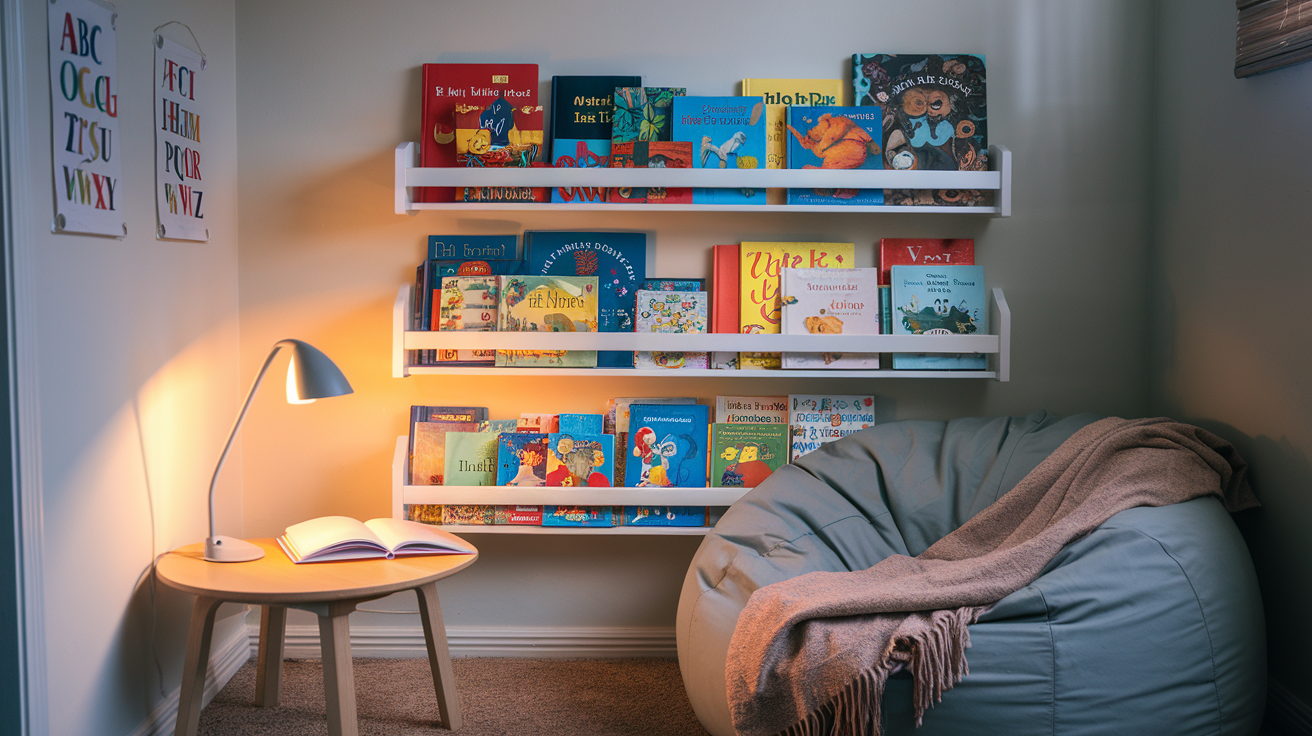
A. Set up a cozy reading corner with good lighting
Want to know the secret to getting your kids hooked on books? Create a space that’s irresistible! Kids gravitate toward comfort, and a dedicated reading nook signals that reading is special.
Start with a soft spot – bean bags, floor pillows, or a small armchair work wonders. My neighbor’s daughter barely touched books until they converted a closet corner with string lights and cushions. Now she disappears there for hours!
Good lighting is non-negotiable. Natural light is ideal during the day, but a warm lamp makes evening reading magical. Avoid harsh overhead lights that cause eye strain or shadows.
The best reading corners feel slightly separate from the main living space – a quiet retreat from the household buzz. Even a corner sectioned off with a small bookshelf or a canopy can create this effect.
B. Build a diverse home library with age-appropriate books
The books you bring home matter enormously. Stock your shelves with variety – picture books, simple readers, non-fiction, poetry, and books that reflect different cultures and experiences.
Age-appropriateness is crucial. Books that are too complex frustrate young readers, while those too simple bore them. Not sure what’s right? Here’s a quick guide:
- Babies/toddlers: Board books, texture books, simple rhymes
- Preschoolers: Picture books with engaging illustrations
- Early readers: Books with predictable patterns, sight words
- Growing readers: Chapter books with illustrations
Quality trumps quantity every time. Ten fantastic books beat fifty mediocre ones. Visit your local library regularly to test-drive books before buying.
C. Display books with covers facing outward for visual appeal
Ever notice how bookstores display bestsellers? They show the covers! There’s psychology behind this – covers are designed to entice readers with colors, characters, and intriguing images.
Traditional bookshelves hide these visual treats behind spines. Instead, use rain gutters mounted on walls, picture ledges, or front-facing display shelves to showcase covers. IKEA spice racks make perfect inexpensive book displays!
When kids see appealing covers, they’re naturally drawn to explore those books. It’s like window shopping for their imagination.
This approach works especially well for younger children who can’t yet read titles on spines. The visual browsing experience makes them feel more independent in their book selection.
D. Rotate books regularly to maintain interest
The fastest way to kill reading enthusiasm? Stagnation. Even beloved books lose their magic when they’re the only options month after month.
Create a book rotation system – keep some books accessible while storing others away. When you bring the stored books back out, kids greet them like long-lost friends.
Timing matters here. Monthly rotations work well for most families, aligning with children’s evolving interests and seasonal themes. Just moved all the dinosaur books to storage? Watch how exciting they become when they reappear!
This rotation strategy also helps you track which books consistently return to favorites status – valuable information about your child’s reading preferences and development.
Make Reading a Daily Ritual
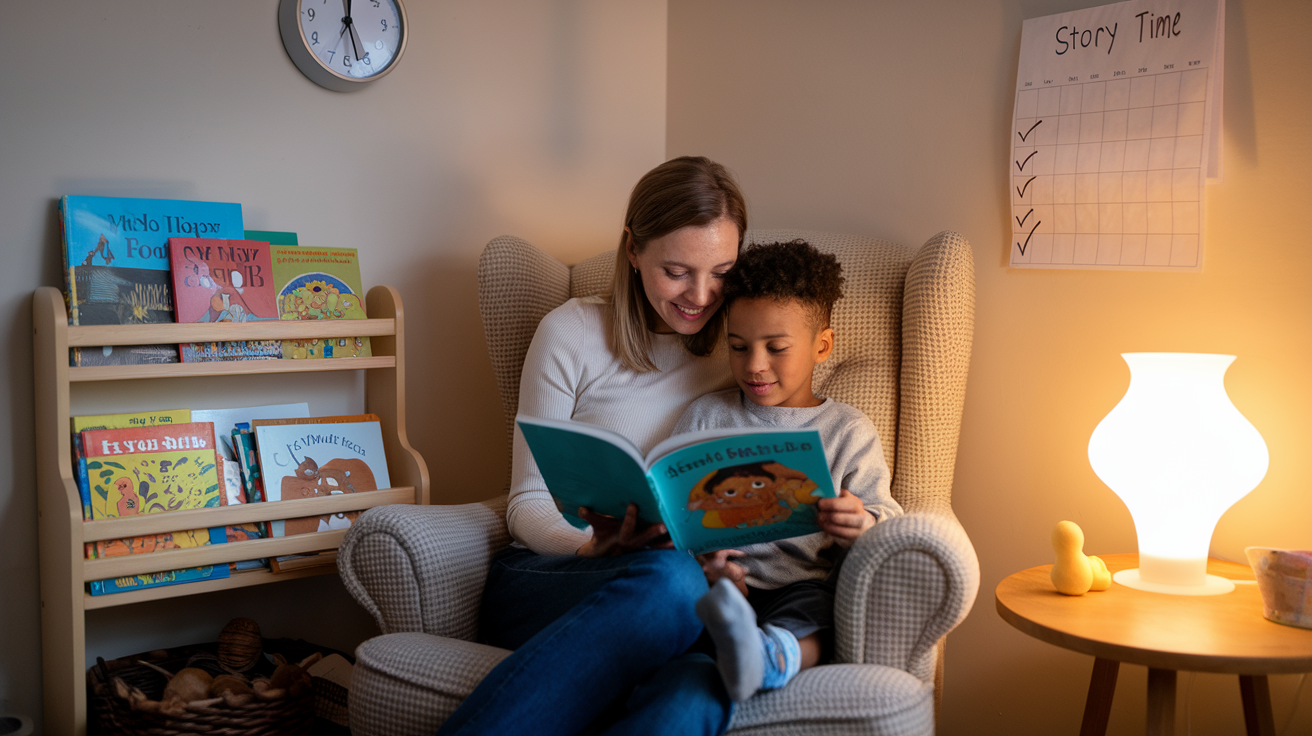
Make Reading a Daily Ritual
Ever notice how kids thrive on routines? Reading works the same way. When you weave books into your daily life, magic happens.
Establish consistent bedtime story routines
Bedtime stories aren’t just cute – they’re powerful. Kids actually look forward to that special time when they curl up with you and a good book. Pick a comfy spot, maybe add some special pillows, and watch as your child begins to associate reading with comfort and security.
“Mom, can we read TWO stories tonight?” becomes the sweetest negotiation you’ll ever have.
The key? Consistency. Same time, same place, different adventures. Your enthusiasm matters too – use funny voices, ask questions, and let them turn the pages. Before long, they’ll be reaching for books on their own.
Start with just 10 minutes daily and gradually increase
Feeling overwhelmed? Start small. Ten minutes is all it takes to plant those reading seeds.
Most parents think they need elaborate reading sessions, but that’s not true. Short, engaging daily reads beat occasional marathon sessions every time. Those ten minutes add up:
| Reading Time | Weekly Total | Monthly Impact |
|---|---|---|
| 10 min/day | 70 minutes | 5 hours |
As your child’s attention span grows, naturally extend your sessions. Follow their lead – if they’re engaged, keep going. If they’re fidgety, wrap it up and try again tomorrow.
Create special weekend reading adventures
Weekends offer perfect opportunities for reading to become an adventure:
- Build blanket forts dedicated to reading
- Visit your local library and make selecting books an event
- Have themed reading picnics at the park
- Let them stay up 15 minutes later on Friday nights for special book time
These aren’t just reading activities – they’re memory-makers. When my daughter and I started our “Saturday morning pancakes and poetry” ritual, she began collecting poems to share all week long.
The real secret? Kids don’t separate reading from the experience surrounding it. Make it special, make it consistent, make it yours.
Lead by Example

A. Let your child see you reading for pleasure
Kids watch everything you do. When they spot you curled up with a good book instead of scrolling through your phone, they’re taking notes.
I remember when my niece caught me laughing at a novel. Her curiosity was immediate: “What’s so funny?” That simple moment led to us sharing the joke and her asking for her own book.
The message is clear – reading isn’t just homework. It’s something adults choose to do because it’s enjoyable. Your children will notice when you pick up a book during your free time, signaling that reading is valued in your home.
B. Share interesting parts from your own reading
Found a fascinating fact? Read it aloud!
“Listen to this…” are magic words that make information special. When you share that cool detail about sharks or that funny line from your novel, you’re showing that books contain treasures worth talking about.
This doesn’t need to be formal. Just spontaneously sharing “Whoa, I just learned that octopuses have three hearts!” creates natural reading enthusiasm.
C. Discuss books and reading preferences as a family
Make books part of your regular conversation. Ask questions like:
- “What was your favorite part of that story?”
- “Which character would you want to be friends with?”
- “What do you think happens after the book ends?”
Talking about stories helps kids process what they’ve read and develops critical thinking skills. Plus, it’s just fun! These discussions show that stories matter and are worth talking about.
D. Visit libraries and bookstores together
Turn book-hunting into an adventure! Libraries and bookstores can become magical destinations when approached with excitement.
Let your kids wander and discover. Watch as they pull books from shelves based on interesting covers or topics. This freedom to explore creates positive associations with reading spaces.
Many libraries offer story times and special events. Make these regular outings that your family looks forward to.
E. Limit your own screen time in favor of books
Actions speak louder than words. If you’re constantly on devices while telling kids to read, they’ll spot the disconnect immediately.
Try setting “screen-free reading time” for the whole family. Maybe it’s 30 minutes before bed or Sunday afternoons. When everyone participates, it becomes special family time rather than a chore.
Your relationship with screens sets the pattern for your children. When they see you choosing books over mindless scrolling, they learn that reading deserves priority in our distraction-filled world.
Connect Reading to Real-Life Experiences
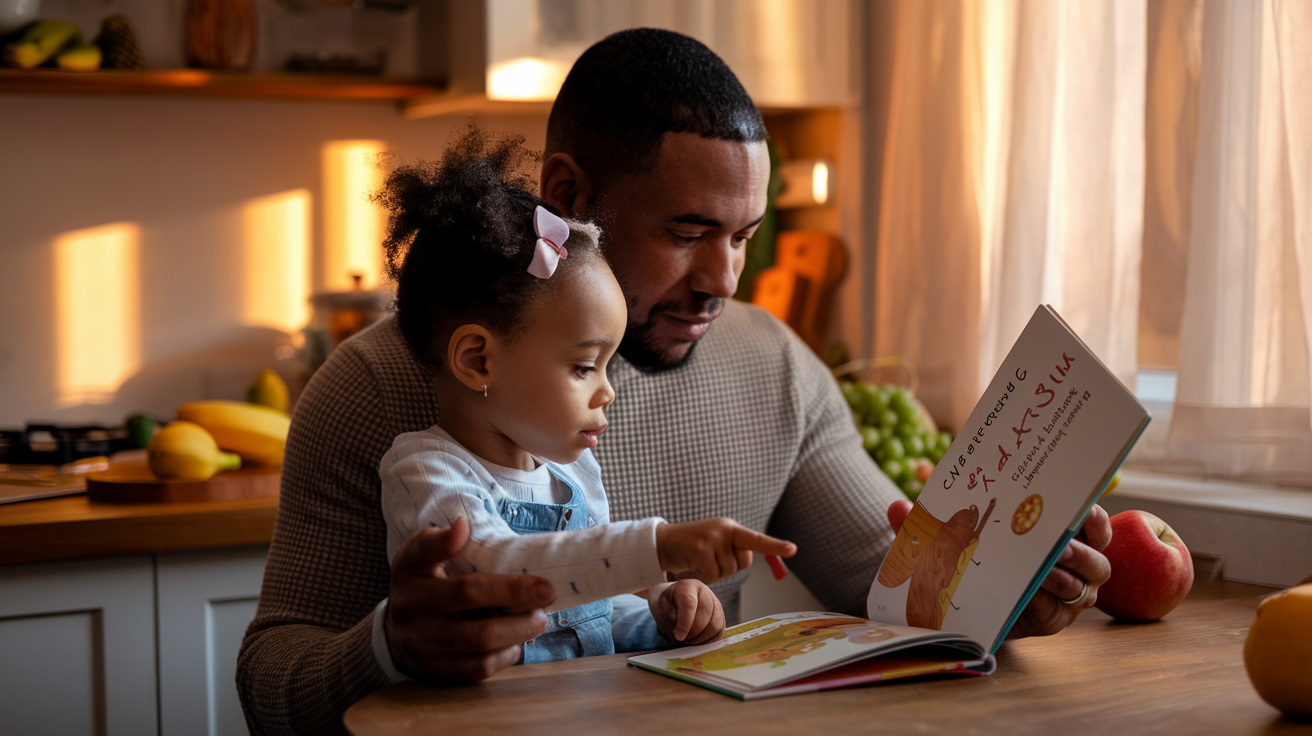
Choose books related to upcoming family activities
Reading shouldn’t feel like some isolated activity that happens only at bedtime. Want to make books truly meaningful? Connect them to what’s happening in your child’s life right now.
Planning a trip to the beach? Grab “Hello Ocean” or “Rainbow Fish.” Getting a new pet? “The Pigeon Wants a Puppy” suddenly becomes hysterical and relevant. Even everyday activities like grocery shopping can be enhanced with books like “Please, Mr. Panda” or “Green Eggs and Ham” before you go.
When kids see stories reflected in their real experiences, the books become meaningful in a whole new way. My nephew was terrified of his first dentist visit until we read “Curious George Visits the Dentist” – suddenly he was the brave one helping others!
Read relevant stories before visiting new places
Kids thrive on preparation. Reading about new experiences before they happen builds confidence and excitement.
Heading to the zoo? Read “Good Night, Gorilla” or “If I Ran the Zoo” first. Your child will recognize animals and concepts when they arrive, making them feel like the expert.
Museum trips get way more interesting when kids already know something about what they’ll see. My friend’s daughter became obsessed with dinosaurs after reading “How Do Dinosaurs Say Goodnight?” before visiting a natural history museum.
Even potentially scary experiences like doctor visits or the first day of school become manageable adventures when children have met book characters who’ve successfully navigated those same situations.
Explore books that reflect your child’s current interests
Got a train-obsessed toddler? A dinosaur enthusiast? A budding astronaut? Following your child’s current passions through books is reading gold.
When kids are genuinely interested in a topic, their motivation to understand text skyrockets. They’ll work harder to comprehend words when they’re desperate to learn if that T-Rex finds his dinner or how the rocket ship lands.
This approach works brilliantly for reluctant readers. My neighbor’s son wouldn’t touch books until she found graphic novels about Minecraft. Now he devours anything with similar themes.
The best part? These interest-based reading journeys often branch out naturally. The train lover might discover books about engineers, travel, or different countries as their interests evolve.
Create book-inspired outings and adventures
Books can inspire amazing real-world adventures that make stories come alive.
Read “We’re Going on a Bear Hunt” then take a nature walk through tall grass, mud, and a stream. Create a treasure hunt based on “How to Find a Friend.” Make pancakes after reading “If You Give a Pig a Pancake.”
These experiences cement reading as something joyful and connected to life, not just an academic exercise. Kids start to see themselves as characters in their own adventures.
One family I know turned “The Giving Tree” into a whole day of park exploration, tree identification, and conversations about friendship. Years later, their daughter still remembers both the book and the day vividly.
Books become powerful when they jump off the page and into your child’s life experiences.
Use Technology Strategically

Explore high-quality interactive storybook apps
Remember when books were just…paper? Not anymore! Today’s kids have amazing digital options that actually make reading more engaging. But not all apps are created equal.
Look for interactive storybook apps that highlight words as they’re read aloud. This text-to-speech feature helps kids connect written words with their sounds—a crucial early reading skill. Apps like Epic!, Storyly, and Reading Eggs offer fantastic libraries of interactive books that grow with your child.
The best apps include gentle animations that enhance understanding without overwhelming the story. They give kids control over the pace and often include comprehension questions that make reading active, not passive.
What sets quality apps apart? They don’t just entertain—they teach. Choose ones with adjustable reading levels so you can increase difficulty as your child progresses.
Try audiobooks for car rides and quiet time
Turn drive time into story time! Audiobooks are reading magic for busy families. They expose kids to vocabulary, complex sentence structures, and storytelling patterns—all while you’re stuck in traffic.
Services like Libby let you borrow audiobooks from your library for free. Audible Kids and Librivox offer thousands of titles appropriate for young listeners.
Pro tip: Start with audiobooks of stories your child already knows and loves, then branch out to new adventures. This builds confidence and comprehension.
The beauty of audiobooks? They model fluent, expressive reading—something crucial for beginning readers. Kids naturally mimic the narrator’s intonation when they eventually read aloud themselves.
Use video calls with relatives for remote story sessions
Grandparents make the best reading buddies, even from miles away. Set up regular video call reading dates with relatives who live far away.
This works brilliantly if you have duplicate copies of books—one at your home and one at Grandma’s. The shared experience makes reading social and special.
Video call reading sessions create meaningful connections while building literacy skills. Your child gets individualized attention, and relatives get quality time with kids they adore.
Ask relatives to occasionally pause and ask questions about the story. This interactive approach improves comprehension and critical thinking skills.
Engage Multiple Senses During Reading Time
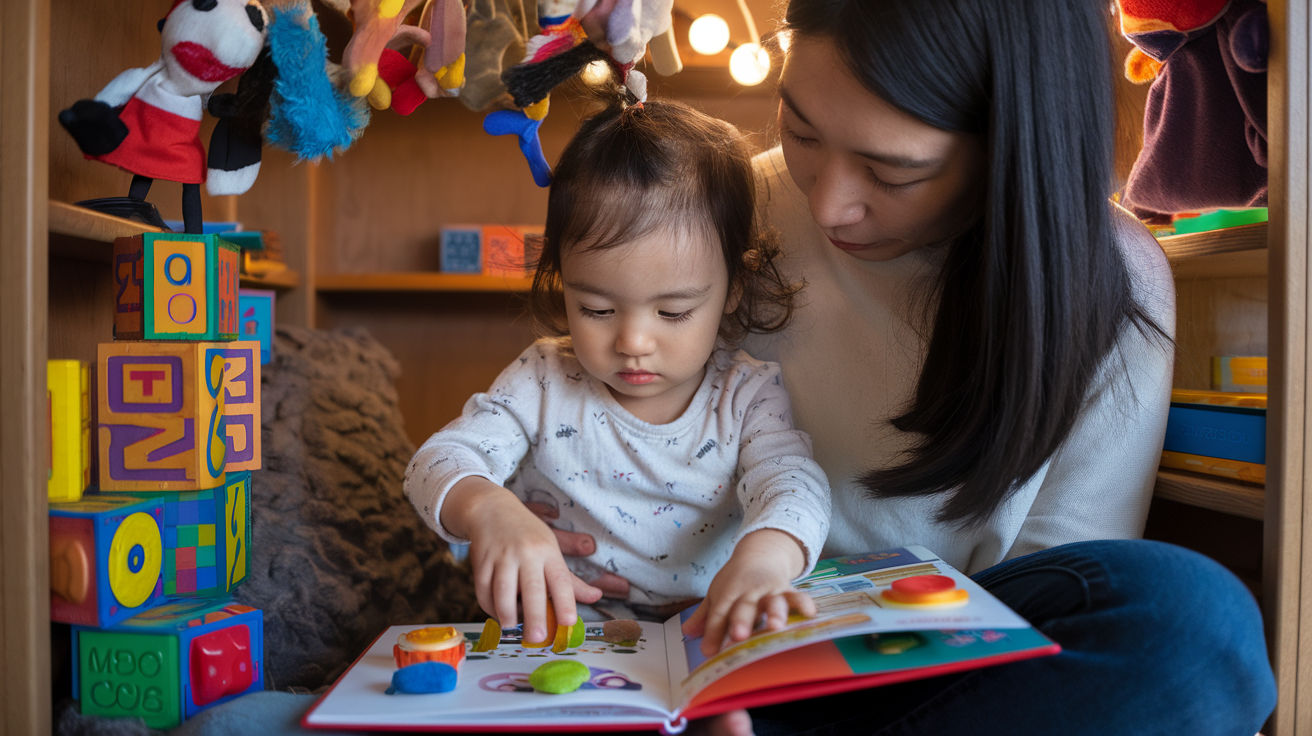
Engage Multiple Senses During Reading Time
Reading isn’t just about seeing words on a page. Kids learn best when they’re fully immersed in stories using all their senses. When you make reading a multi-sensory experience, you’re not just building literacy skills—you’re creating memories that make books special.
Use different voices for characters
Ever noticed how your child perks up when you use a squeaky voice for the mouse or a deep growl for the bear? That’s because voice variation instantly makes stories come alive.
You don’t need to be a professional voice actor. Just changing your pitch, speed, or adding a silly accent works wonders. Try whispering for shy characters or speaking loudly for bold ones. When my daughter was four, she’d giggle uncontrollably at my terrible British accent for Paddington Bear—and guess what became her favorite book to request night after night?
Encourage acting out favorite scenes
After reading “We’re Going on a Bear Hunt,” why not actually go on one? Turn your living room into a setting from the story. Stomp through imaginary mud, swim through pretend rivers, or tiptoe past sleeping bears.
This physical engagement cements story elements in children’s minds while making reading an active, joyful experience. Simple props like hats, stuffed animals, or household items can transform story time into theater time. These playful moments help kids connect emotionally with characters and understand plot sequences.
Create simple crafts based on stories
Crafting extends the story experience beyond the final page. After reading “The Very Hungry Caterpillar,” cut circles from colored paper to create your own caterpillar. For “Rainbow Fish,” glue aluminum foil scales onto a paper fish.
These hands-on activities reinforce comprehension while developing fine motor skills. They also provide concrete ways to discuss the story: “Why did you make your caterpillar so big?” opens conversations about story details and personal interpretations.
The craft doesn’t need to be complicated—even drawing a simple picture about the favorite part of the story counts. What matters is connecting the physical creation to the narrative experience.
Build Vocabulary Through Conversation

Explain unfamiliar words during reading
Ever notice how kids stop and squint when they hit a word they don’t know? That’s your golden opportunity! When your child stumbles on “enormous” or “peculiar,” don’t just tell them what it means—make it stick.
“This dinosaur is enormous—that means super, super big. Like, bigger than our car, bigger than our house!”
The magic happens when you connect new words to things they already understand. Point to pictures that show the word in action or act it out with dramatic flair. Your child will remember “slithered” much better if you wiggle across the floor like a snake while explaining it.
Play word games related to recent books
Turn car rides into vocabulary-building powerhouses with simple games tied to books you’ve read:
“I spy something from Pete the Cat that starts with B!”
“Let’s name all the animals from The Gruffalo!”
For older kids, try the synonym game. “What’s another word for ‘happy’ from our story?” Start with easy ones and gradually challenge them with tougher alternatives.
Create a “new words” wall to track learning
Kids love seeing their progress. Designate a wall space or poster board as your “Word Collector.” Every time your child learns a new word from reading, write it on a colorful sticky note and add it to the collection.
Take photos of the actual objects or draw quick pictures next to the words. Review them together weekly, making it a celebration: “Wow, you learned 12 new words this month!”
Use rich language in everyday conversations
Drop the baby talk. Seriously. Your four-year-old can absolutely handle “disappointed” instead of “sad” and “ecstatic” instead of “happy.”
“I’m famished after that long walk. Should we prepare a nutritious snack?”
When setting the table, talk about “arranging” the “utensils” instead of “putting out forks.” Bath time can involve “submerging” toys. Grocery shopping introduces “selecting” and “examining” produce.
The real trick? Don’t make it a vocabulary lesson. Just weave better words into everyday talk. Kids soak up language like sponges when it’s natural and meaningful.
Foster Independence in Reading
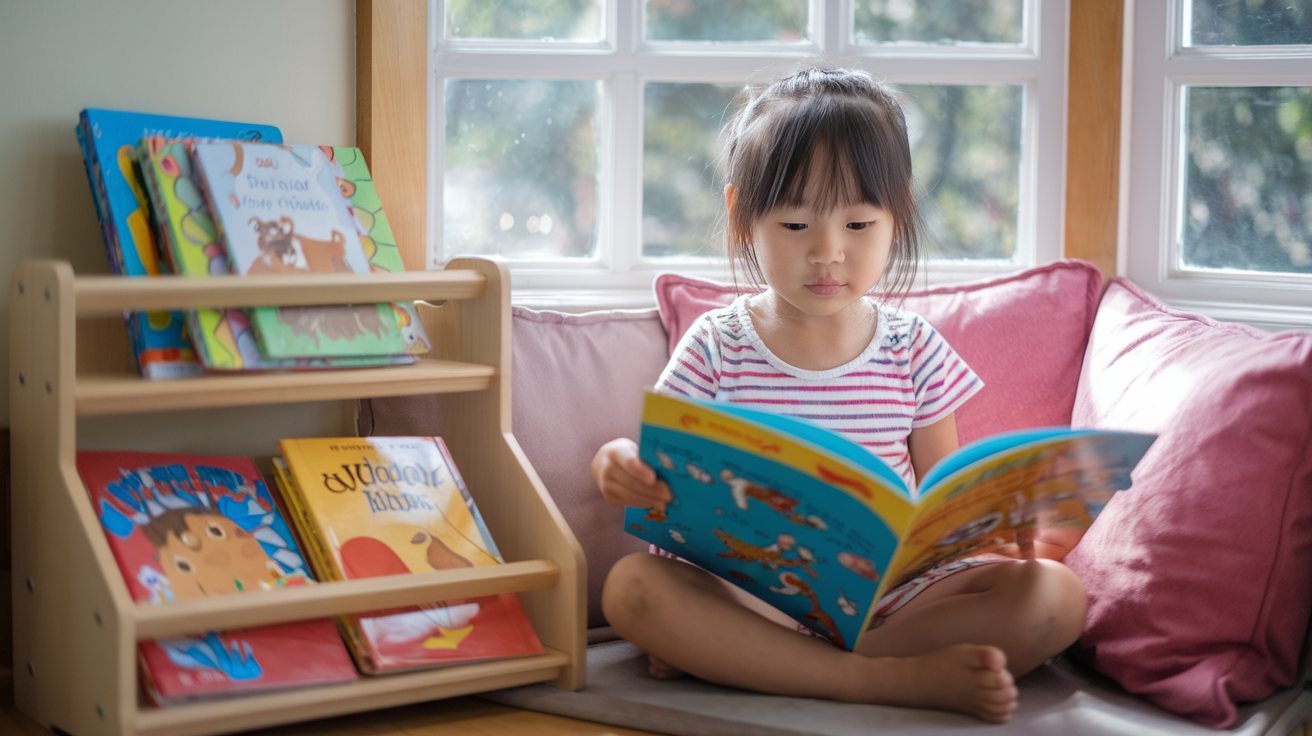
Encourage page-turning and book handling
Kids feel a special kind of pride when they can handle books themselves. It’s like their very own superpower! Hand over board books to your little ones and let them flip through pages at their own pace. Don’t worry about them going backward or skipping sections – they’re building confidence with every page turn.
You might say, “Look how you’re holding that book all by yourself!” or “I love watching you turn the pages.” These small encouragements go a long way.
For babies and toddlers, try books with interactive elements like flaps, textures, or sound buttons. They’ll get hooked on the physical experience of reading before they even understand all the words.
Create opportunities for “pretend reading”
Ever notice how your child “reads” their favorite book even though they can’t actually read yet? That’s golden! Pretend reading is a massive step toward literacy.
After reading a story multiple times, hand it over and say, “Now it’s your turn to read to me!” or “Can you tell me what happens in this story?”
Your child might recite parts from memory, make up new details, or describe pictures. Whatever they do, it’s building their storytelling muscles and boosting their confidence. I’ve seen children flip through books, mumbling story-like sounds while pointing at pictures – that’s literacy in action!
Celebrate attempts at sounding out words
The road to reading is paved with adorable mispronunciations and creative guesses. When your child points to a word and gives it their best shot, that’s worth celebrating!
Instead of immediately correcting them, try saying, “I love how you’re trying to figure that out!” or “That was a great try!” Then, you can gently provide the correct pronunciation without making them feel wrong.
Remember that moment when your child recognized their first word without help? Pure magic! Keep that magic alive by celebrating each attempt, whether they nail it or not.
Allow children to choose their own books
Nothing kills the joy of reading faster than being forced to read something boring. Take regular trips to the library or bookstore and let your child roam the children’s section. You might be surprised by what captures their interest!
Maybe they’ll pick books about dinosaurs for three months straight. That’s perfectly fine! Their reading choices might seem random or repetitive, but following their interests builds a powerful connection between reading and pleasure.
Create a special spot at home where your child can access their books anytime. A low shelf, a basket, or a cozy reading nook gives them ownership of their reading journey.
Connect Reading with Writing

Connect Reading with Writing
Ever wonder why some kids pick up reading so naturally? The secret often lies in connecting reading with writing activities. When children see the link between the words they read and the words they can create, something magical happens.
Create homemade books together
Homemade books are pure gold for budding readers. Grab some paper, fold it in half, and you’ve got a blank canvas ready for your child’s imagination. Let them draw pictures about their day, their favorite toy, or that imaginary friend only they can see.
Then, sit with them and help write simple words describing their illustrations. Maybe they dictate the story while you write, or maybe they try writing some words themselves. Either way, they’re seeing their thoughts transform into stories they can read over and over.
My friend’s daughter created a book about her pet turtle that she read every night for months. That book did more for her reading skills than any flashcard session ever could.
Write letters to book characters
Kids fall in love with book characters all the time. Why not encourage them to write to these fictional friends?
“Dear Pigeon, please drive my school bus tomorrow.”
“Dear Llama Llama, what do you do when you’re not with your mama?”
This simple activity reinforces story comprehension while giving kids a purpose for writing. And boy, do children light up when you suggest that maybe, just maybe, the character might write back! (Hint: they absolutely should, with your help of course.)
Start a simple family journal
A family journal sitting on your coffee table can become the heartbeat of your home’s literacy efforts. Nothing fancy needed—just a regular notebook where family members jot down thoughts, draw pictures, or paste photos.
Take turns writing about your day, documenting funny things that happened, or recording special moments. Even the youngest family members can participate by dictating their entries or adding drawings.
The beauty of a family journal is that children see writing and reading as natural parts of daily life—not just school activities. They’ll eagerly flip through past entries, reading memories and watching their own writing skills develop over time.
Make Reading Social
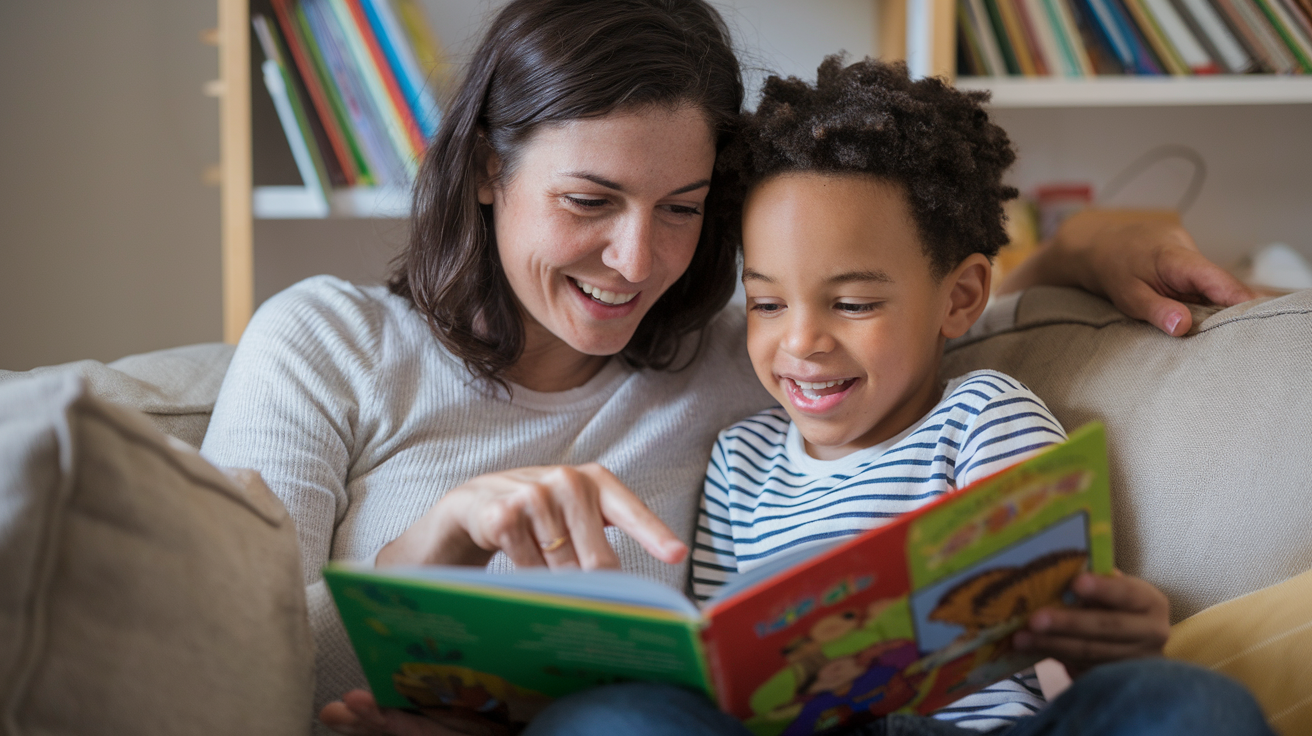
Organize mini book clubs with friends
Reading doesn’t have to be a solo activity! When kids share books with friends, magic happens. My neighbor started a monthly “Tiny Readers Club” where her 5-year-old invited three friends over. They each brought their favorite picture book, took turns “presenting” it, and then did a simple craft related to one of the stories.
The excitement on those little faces when talking about their favorite characters? Priceless. They weren’t just reading—they were bonding over stories.
Try this: set up a recurring playdate with a reading theme. Keep it short (30-45 minutes max), provide snacks shaped like book characters, and create a special “reading fort” with pillows and blankets.
Share books with cousins and neighbors
Creating a neighborhood book exchange builds community while promoting literacy. Start a “Little Free Library” on your porch or set up a monthly book swap with nearby families.
My sister’s kids exchange book packages with their cousins who live across the country. They include notes about why they loved certain stories and sometimes add small toys related to the books. This simple practice has them checking the mail eagerly and reading with purpose.
Attend library story hours
Libraries are literacy wonderlands—and most offer free weekly story times! These sessions expose children to professional read-aloud, new books, and other little readers.
Library story times also teach kids to sit, listen, and participate in a group setting—all crucial skills for kindergarten readiness. Most include songs, fingerplays, and sometimes crafts that reinforce the stories.
Join online reading challenges appropriate for young children
Digital reading programs add excitement through rewards and tracking. Many libraries run summer reading challenges with prizes, but year-round options exist too.
The PBS Kids Reading Buddies program lets children log books and earn digital badges. Scholastic’s Home Base features reading streaks and games tied to popular book series.
One mom told me her reluctant reader transformed after joining a “100 Books Before Kindergarten” challenge. That visible progress chart on the refrigerator motivated daily reading sessions—turning obligation into achievement.
Celebrate Reading Milestones
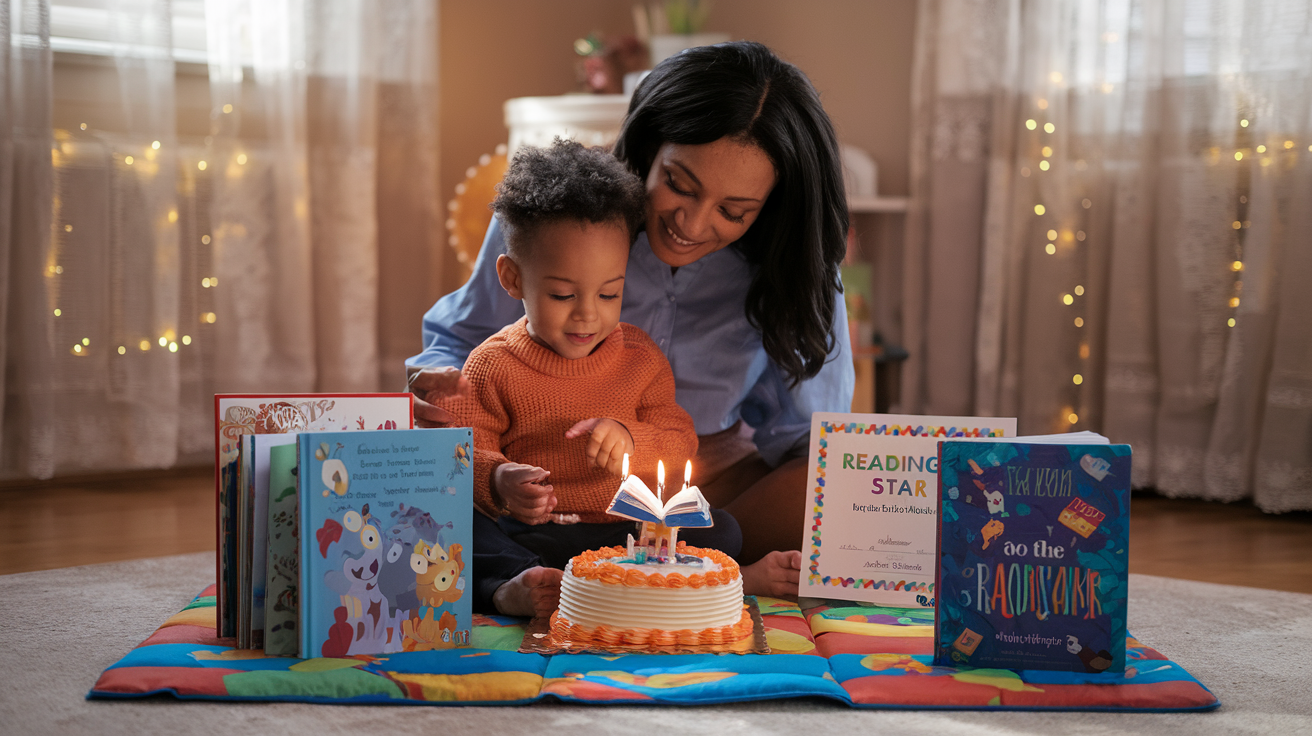
Celebrate Reading Milestones
Kids thrive on recognition. When you celebrate their reading achievements, you’re not just acknowledging their progress—you’re building a lifelong love of books.
Create a reading chart with stickers or stamps
Nothing lights up a child’s face quite like earning a sticker! A colorful reading chart on the refrigerator or bedroom wall works wonders for motivation. Keep it simple for younger kids—maybe one sticker per book—and more detailed for older ones who might track minutes or pages.
My nephew Jake went from reluctant reader to book enthusiast after my sister created a rocket ship chart where he could “fly to the moon” by completing books. Each book earned him a star sticker, and reaching the moon meant a trip to the bookstore.
The visual progress is what makes these charts so effective. Kids can literally see how far they’ve come!
Plan special rewards for reading achievements
Reading rewards don’t need to be expensive—they just need to feel special. Maybe it’s staying up 15 minutes later, choosing dinner, or a small toy after finishing a challenging book.
Some reward ideas that have worked for families I know:
- A special one-on-one outing with a parent
- Getting to pick the weekend family activity
- A book-themed celebration (Harry Potter movie night after finishing the book!)
- A reading certificate they can proudly display
Take photos of reading moments to look back on
We take photos of first steps and lost teeth—why not first books? Snap pictures of your child reading in funny places, tackling challenging books, or simply lost in a story.
Create a dedicated album on your phone or even a physical “Reading Journey” scrapbook. Kids love seeing themselves as readers, and these photos become powerful reminders of their growth.
The magic happens when you look back together. “Remember when these chapter books seemed impossible? Now look at you!”
Address Reading Challenges Positively
Break reading into smaller, manageable sessions
Every child moves at their own pace. When your little one struggles with reading, don’t push them through long sessions that leave everyone frustrated. Instead, try the “five-minute rule” – just five minutes of reading, but make it consistent.
You’d be surprised how these short bursts add up! A quick bedtime story snippet or even reading cereal boxes at breakfast counts. The magic happens when reading becomes a regular part of your routine rather than a dreaded marathon.
I’ve seen parents transform reading battles into bonding moments just by scaling back. One mom told me, “We went from tears every night to my daughter asking for ‘just one more page’ once we stopped watching the clock.”
Find books specifically designed for reluctant readers
The publishing world has finally caught up with what kids actually want to read! High-interest, low-difficulty books are game-changers for struggling readers. These books pack exciting stories into simpler text.
Look for:
- Books with larger print and more space between lines
- Stories with fewer words per page but compelling plots
- Series like “Dog Man,” “Captain Underpants,” or “Diary of a Wimpy Kid”
- Graphic novels that support text with visual storytelling
Remember when you were a kid? We all had topics we couldn’t get enough of. Dinosaurs, unicorns, sports, or outer space – whatever lights up your child’s eyes is your golden ticket to reading engagement.
Consult with teachers about personalized strategies
Your child’s teacher has seen it all before. They’re not just classroom managers – they’re reading specialists with tricks up their sleeves for every type of learner.
Schedule a quick chat (doesn’t have to be formal) and ask:
- What specific techniques work for your child at school
- Which reading level is the “just right” challenge level
- Whether any particular reading approach might benefit your child
- What accommodations might help at home
Teachers can spot patterns you might miss and suggest targeted approaches. Maybe your child needs more phonics practice, or perhaps they thrive with audio support while reading along.
Focus on enjoyment rather than performance
The fastest way to kill reading motivation? Turning every book into a pop quiz.
When we obsess over perfect pronunciation or comprehension questions after every paragraph, we’re teaching kids that reading is work, not pleasure. Instead, laugh together at funny parts, gasp at surprises, and chat naturally about stories.
Reading success looks different than we sometimes think. The child who devours comics, reads the same book ten times, or only wants books about trucks is still developing crucial literacy skills. They’re learning that text contains stories worth exploring.
The goal isn’t raising perfect readers – it’s raising kids who choose to read because they love it.
Fostering early reading skills at home is a journey filled with discovery, connection, and growth. By creating a reading-rich environment, establishing daily reading rituals, and modeling a love for books yourself, you’re setting the foundation for lifelong literacy. Remember that reading development thrives when connected to real-world experiences, supported by appropriate technology, and engaged through multiple senses. Building vocabulary through rich conversations, encouraging independent reading choices, and connecting reading with writing further strengthens these essential skills.
The path to raising a reader doesn’t have to be traveled alone. Make reading social by sharing stories with friends and family, celebrate every milestone along the way, and approach challenges with patience and positivity. Your consistent efforts today will help your child develop not just reading proficiency, but a genuine love of books that will serve them throughout their entire lives. Start implementing these strategies today, and watch as your home transforms into a place where reading is not just taught, but truly treasured.















